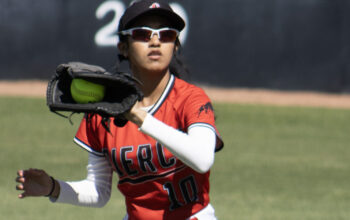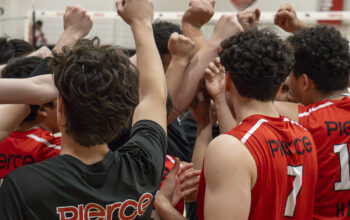Injuries are not uncommon for athletes; however, a head injury can alter a person’s life in an instance and Pierce is taking the necessary precautions to help its players.
In recent years, due to the awareness of head injuries —more specifically concussions — professional and collegiate levels of athletics have made it a priority to deal with these types of injuries more seriously.
Pierce Athletic Trainer Leonard Ramirez has made it an emphasis on the players that a head injury is something that should not be taken lightly.
“If you have a concussion you need to tell someone. You can’t hide it like back in the old days,” Ramirez said.
Ramirez has adopted guidelines from the National Collegiate Athletic Association for himself and his staff to follow.
“The NCAA basically has put in some guidelines since 2009 and we follow what they do to help test for concussions,” Ramirez said.
Part of the procedure to educate the athletes about concussions includes players watching a video done by ESPN’s “E:60” about former college athlete Preston Prevletes.
“The players are required to watch this video,” said Athletic Director Bob Lofrano.
Newly-hired athletic trainer Robert Horowrtz said that watching the Prevletes video is not only for the players but for the coaches as well.
“Even the coaches are required to see a video on concussions and they are supposed to sign off that they have seen the video, they understand the video and understand the consequences of the concussion,” Horowrtz said.
The documentary not only shows the importance of dealing with a concussion properly, but playing with this type of injury too soon could be fatal.
“It is the second concussion that is the dangerous one, not the original/initial one,” Ramirez said.
Horowrtz added onto Ramirez’s comment, explaining what occurs in the brain after the initial concussion.
“When you originally get a concussion there is a cascade and all different types of chemical reactions are going on and you have to let that settle down,” Horowrtz said. “If any trauma happens at that crucial period it goes down hill really quick.”
The athletic trainers and their staff try to avoid getting to this position by working diligently to assess the situation efficiently with the procedures they have been implementing.
“We give everyone a baseline test before the season starts. We are getting these kids when they are supposed healthy with no dings on them, no injuries,” Ramirez said.
These tests help give the trainers a marker for each athlete in the case of a head injury to help diagnose them properly.
“If something were to happen on the volleyball court or football field then we retest them with that same test to check differences,” Ramirez said.
Horowrtz explains that at a game when a concussion occurs they hold the player out and go through some questions similar to the original test and there is a score the trainers look at. After that they test the player again a day or two later.
“There’s a prescreen, injury screen and postinjury screen,” Horowrtz said. “There are certain numbers we look for.”
Despite the guidelines and procedures of the present, the trainers have to look into the athletes past as well.
“Sometimes the athletes will not remember or tell us that they have had a previous concussion and usually that’s where we have to make sure that they are very clear on that because if they are not clear on that it skewers everything,” Horowrtz said.
A main concern for the training staff and the athletes is that after the first concussion an individual is more likely to get another one.
“Does not matter if it was a year ago or two years ago, it is still a concussion,” Horowrtz said. Usually what happens after a concussion is that you are more susceptible to a second or third or fourth concussion.”
In some more serious instances the training staff has to send the players to a neurologist for further analysis.
“We would like to send them to a neurologist especially if they have had more than one concussion or something does not seem right,” Horowrtz said.
Although there is a training staff on campus the real responsibility of dealing with an injury like a concussion falls on the individual athletes.
“Everyone has the responsibility to police everybody,” Ramirez said.
If you are a personal trainer and want peace of mind in the event of client sustaining an injury, check out Personal Trainer Insurance From Salon Gold.



